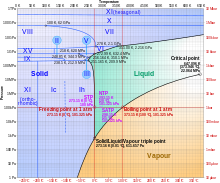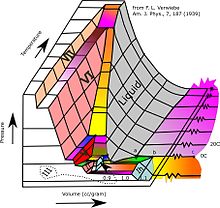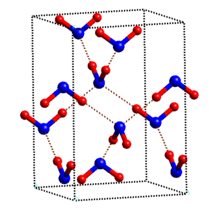
A | B | C | D | E | F | G | H | CH | I | J | K | L | M | N | O | P | Q | R | S | T | U | V | W | X | Y | Z | 0 | 1 | 2 | 3 | 4 | 5 | 6 | 7 | 8 | 9

The phases of ice are all possible states of matter for water as a solid. Currently, 19 phases, including both crystalline and amorphous ice, have been observed at various densities.
Theory
Most liquids under increased pressure freeze at higher temperatures because the pressure helps to hold the molecules together. However, the strong hydrogen bonds in water make it different: for some pressures higher than 1 atm (0.10 MPa), water freezes at a temperature below 0 °C. Subjected to higher pressures and varying temperatures, ice can form in nineteen separate known crystalline phases. With care, at least fifteen of these phases (one of the known exceptions being ice X) can be recovered at ambient pressure and low temperature in metastable form.[1][2] The types are differentiated by their crystalline structure, proton ordering,[3] and density. There are also two metastable phases of ice under pressure, both fully hydrogen-disordered; these are Ice IV and Ice XII.
Crystal structure


The accepted crystal structure of ordinary ice was first proposed by Linus Pauling in 1935. The structure of ice Ih is the wurtzite lattice, roughly one of crinkled planes composed of tessellating hexagonal rings, with an oxygen atom on each vertex, and the edges of the rings formed by hydrogen bonds. The planes alternate in an ABAB pattern, with B planes being reflections of the A planes along the same axes as the planes themselves.[4] The distance between oxygen atoms along each bond is about 275 pm and is the same between any two bonded oxygen atoms in the lattice. The angle between bonds in the crystal lattice is very close to the tetrahedral angle of 109.5°, which is also quite close to the angle between hydrogen atoms in the water molecule (in the gas phase), which is 105°.
This tetrahedral bonding angle of the water molecule essentially accounts for the unusually low density of the crystal lattice – it is beneficial for the lattice to be arranged with tetrahedral angles even though there is an energy penalty in the increased volume of the crystal lattice. As a result, the large hexagonal rings leave almost enough room for another water molecule to exist inside. This gives naturally occurring ice its rare property of being less dense than its liquid form. The tetrahedral-angled hydrogen-bonded hexagonal rings are also the mechanism that causes liquid water to be densest at 4 °C. Close to 0 °C, tiny hexagonal ice Ih-like lattices form in liquid water, with greater frequency closer to 0 °C. This effect decreases the density of the water, causing it to be densest at 4 °C when the structures form infrequently.
In the best-known form of ice, ice Ih, the crystal structure is characterized by the oxygen atoms forming hexagonal symmetry with near tetrahedral bonding angles. This structure is stable down to −268 °C (5 K; −450 °F), as evidenced by x-ray diffraction[5] and extremely high resolution thermal expansion measurements.[6] Ice Ih is also stable under applied pressures of up to about 210 megapascals (2,100 atm) where it transitions into ice III or ice II.[7]
Amorphous ice
While most forms of ice are crystalline, several amorphous (or "vitreous") forms of ice also exist. Such ice is an amorphous solid form of water, which lacks long-range order in its molecular arrangement. Amorphous ice is produced either by rapid cooling of liquid water to its glass transition temperature (about 136 K or −137 °C) in milliseconds (so the molecules do not have enough time to form a crystal lattice), or by compressing ordinary ice at low temperatures. The most common form on Earth, low-density ice, is usually formed in the laboratory by a slow accumulation of water vapor molecules (physical vapor deposition) onto a very smooth metal crystal surface under 120 K. In outer space it is expected to be formed in a similar manner on a variety of cold substrates, such as dust particles.[8] By contrast, hyperquenched glassy water (HGW) is formed by spraying a fine mist of water droplets into a liquid such as propane around 80 K, or by hyperquenching fine micrometer-sized droplets on a sample-holder kept at liquid nitrogen temperature, 77 K, in a vacuum. Cooling rates above 104 K/s are required to prevent crystallization of the droplets. At liquid nitrogen temperature, 77 K, HGW is kinetically stable and can be stored for many years.
Amorphous ices have the property of suppressing long-range density fluctuations and are, therefore, nearly hyperuniform.[9] Despite the epithet "ice", classification analysis utilizing neural networks has shown that amorphous ices are glasses.[10]
Pressure-dependent states

Ice from a theorized superionic water may possess two crystalline structures. At pressures in excess of 50 GPa (7,300,000 psi) such superionic ice would take on a body-centered cubic structure. However, at pressures in excess of 100 GPa (15,000,000 psi) the structure may shift to a more stable face-centered cubic lattice. Some estimates suggest that at an extremely high pressure of around 1.55 TPa (225,000,000 psi), ice would develop metalic properties.[12]
Heat and entropy

Ice, water, and water vapour can coexist at the triple point, which is exactly 273.16 K (0.01 °C) at a pressure of 611.657 Pa.[14][15] The kelvin was defined as 1/273.16 of the difference between this triple point and absolute zero,[16] though this definition changed in May 2019.[17] Unlike most other solids, ice is difficult to superheat. In an experiment, ice at −3 °C was superheated to about 17 °C for about 250 picoseconds.[18]

The latent heat of melting is 5987 J/mol, and its latent heat of sublimation is 50911 J/mol. The high latent heat of sublimation is principally indicative of the strength of the hydrogen bonds in the crystal lattice. The latent heat of melting is much smaller, partly because liquid water near 0 °C also contains a significant number of hydrogen bonds. By contrast, the structure of ice II is hydrogen-ordered, which helps to explain the entropy change of 3.22 J/mol when the crystal structure changes to that of ice I. Also, ice XI, an orthorhombic, hydrogen-ordered form of ice Ih, is considered the most stable form at low temperatures.
The transition entropy from ice XIV to ice XII is estimated to be 60% of Pauling entropy based on DSC measurements.[19] The formation of ice XIV from ice XII is more favoured at high pressure.[20]
When medium-density amorphous ice is compressed, released and then heated, it releases a large amount of heat energy, unlike other water ices which return to their normal form after getting similar treatment.[21]
Hydrogen disorder

The hydrogen atoms in the crystal lattice lie very nearly along the hydrogen bonds, and in such a way that each water molecule is preserved. This means that each oxygen atom in the lattice has two hydrogens adjacent to it: at about 101 pm along the 275 pm length of the bond for ice Ih. The crystal lattice allows a substantial amount of disorder in the positions of the hydrogen atoms frozen into the structure as it cools to absolute zero. As a result, the crystal structure contains some residual entropy inherent to the lattice and determined by the number of possible configurations of hydrogen positions that can be formed while still maintaining the requirement for each oxygen atom to have only two hydrogens in closest proximity, and each H-bond joining two oxygen atoms having only one hydrogen atom.[22] This residual entropy S0 is equal to 3.4±0.1 J mol−1 K−1 .[23]
Calculations
There are various ways of approximating this number from first principles. The following is the one used by Linus Pauling.[24][25]
Suppose there are a given number N of water molecules in an ice lattice. To compute its residual entropy, we need to count the number of configurations that the lattice can assume. The oxygen atoms are fixed at the lattice points, but the hydrogen atoms are located on the lattice edges. The problem is to pick one end of each lattice edge for the hydrogen to bond to, in a way that still makes sure each oxygen atom is bond to two hydrogen atoms.
The oxygen atoms can be divided into two sets in a checkerboard pattern, shown in the picture as black and white balls. Focus attention on the oxygen atoms in one set: there are N/2 of them. Each has four hydrogen bonds, with two hydrogens close to it and two far away. This means there are allowed configurations of hydrogens for this oxygen atom (see Binomial coefficient). Thus, there are 6N/2 configurations that satisfy these N/2 atoms. But now, consider the remaining N/2 oxygen atoms: in general they won't be satisfied (i.e., they will not have precisely two hydrogen atoms near them). For each of those, there are 24 = 16 possible placements of the hydrogen atoms along their hydrogen bonds, of which 6 are allowed. So, naively, we would expect the total number of configurations to be
Using Boltzmann's entropy formula, we conclude that
The same answer can be found in another way. First orient each water molecule randomly in each of the 6 possible configurations, then check that each lattice edge contains exactly one hydrogen atom. Assuming that the lattice edges are independent, then the probability that a single edge contains exactly one hydrogen atom is 1/2, and since there are 2N edges in total, we obtain a total configuration count , as before.
Refinements

This estimate is 'naive', as it assumes the six out of 16 hydrogen configurations for oxygen atoms in the second set can be independently chosen, which is false. More complex methods can be employed to better approximate the exact number of possible configurations, and achieve results closer to measured values. Nagle (1966) used a series summation to obtain .[26]
As an illustrative example of refinement, consider the following way to refine the second estimation method given above. According to it, six water molecules in a hexagonal ring would allow configurations. However, by explicit enumeration, there are actually 730 configurations. Now in the lattice, each oxygen atom participates in 12 hexagonal rings, so there are 2N rings in total for N oxygen atoms, or 2 rings for each oxygen atom, giving a refined result of .[27]
Known phases
These phases are named according to the Bridgman nomenclature. The majority have only been created in the laboratory at different temperatures and pressures.[28]
| Phase | Year of discovery | Temperature thresholds | Pressure thresholds | Density | Crystal form | Other characteristics |
|---|---|---|---|---|---|---|
| Ice Ih | NA (always known) | 0 °C (32 °F) (freezing) | NA (atmospheric) | 0.917 g/cm3 | Hexagonal | Virtually all ice in the biosphere is ice Ih, with the exception only of a small amount of ice Ic. Has a refractive index of 1.31. |
| Ice Ic | 1943/2020[29][30] | 130 and 220 K (−143 and −53 °C) (formation)/240 K (−33 °C) (conversion to Ice Ih)[31][32] | NA (atmospheric) | Similar to Ice Ih | Diamond[33] | A metastable cubic crystalline variant of ice. |
| Low-density amorphous ice (LDA) | 1930s[34] | NA (atmospheric or lower) | 0.94 g/cm3 [35] | NA (amorphous) | Likely the most common phase in the universe.[34] More viscous than normal water.[35][36][37] | |
| Medium-density amorphous ice (MDA) | 2023[21][38] | −200 °C (−328.0 °F) (freezing) | NA (requires shear force) | 1.06±0.06 g cm3[39] | NA (amorphous) | Experimental procedure generates shear force by crushing ice into powder with centimeter-wide stainless-steel balls added to its container. |
| High-density amorphous ice (HDA) | 1984[40] | <140 K (−133 °C) (normal formation); <30 K (−243.2 °C) (vapor deposition)[35][41] 77 K (−196.2 °C) (stability point)[40] | At 77 K (−196.2 °C): 1.6 GPa (formation from Ih);[40] 0.5nbsp;GPa (formation from LDA)[42] | 1.17 g/cm3 (ambient pressure)[40] | NA (amorphous) | |
| Very high-density amorphous ice (VHDA) | 1996[43] | 160 K (−113 °C) (formation from HDA); 77 K (−196.2 °C) (stability point) | 1 and 2 GPa (formation at 160 K (−113 °C)); ambient (at 77 K (−196.2 °C)) | 1.26 g/cm3 (77 K (−196.2 °C); ambient pressure)[44] | NA (amorphous) | |
| Ice II | 1900[45] | 190 K (−83 °C)-210 K (−63 °C) (formation from ice Ih); 77 K (−196.2 °C) (stability point)[45] | 300 MPa[46] | Rhombohedral | ||
| Ice III | 1900[45] | 250 K (−23 °C) (formation from liquid water); 77 K (−196.2 °C) (stability point)[45] | 300 MPa (formation from liquid water)[46] | 1160 kg/m3 (at 350 MPa)[47] | Tetragonal | Very high relative permittivity at 117. A specific gravity of 1.16 with respect to water. |
| Ice IV | 1900[45] | 190 K (−83 °C)-210 K (−63 °C) (formation from HDA); 77 K (−196.2 °C) (stability point) | 810 MPa (formation from HDA) | Rhombohedral | Typically requires a nucleating agent to form.[48] | |
| Ice V | 1900s[49] | 253 K (−20 °C) (formation from liquid water) | 500 MPa (formation from liquid water) [50] | 1.24 g cm3 (at 350 MPa).[51] | Monoclinic | Zdroj:https://en.wikipedia.org?pojem=Ice_X









